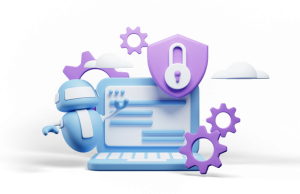Did you know that a specific form of cybercrime costs businesses millions of dollars each year? This costly threat is known as credential abuse, where criminals use stolen usernames and passwords to access company accounts, leading to account takeover fraud. In today’s digital landscape, it has become one of the most prevalent and damaging threats to businesses. Understanding what credential abuse entails, its impact on businesses, and the strategies to identify and prevent it are crucial for maintaining cybersecurity. This article delves into these aspects and explores how Rainbow Secure offers robust protection against credential abuse.
What is Credential Abuse?
Credential abuse occurs when cybercriminals gain unauthorized access to systems, networks, or accounts by using stolen, guessed, or otherwise compromised login credentials. Common methods of credential abuse include:
- Phishing: Tricking users into providing their login details via fake emails or websites.
- Credential Stuffing: Using automated tools to try many username-password combinations, often sourced from previous data breaches.
- Brute Force Attacks: Systematically guessing passwords until the correct one is found.
- Social Engineering: Manipulating individuals into divulging confidential information.
Why has credential abuse become a popular form of cybercrime?
- Ease of Obtaining Stolen Credentials:
Criminals can easily access personal data through phishing attacks, data breaches, and malware infections. These methods allow attackers to collect vast amounts of login information with minimal effort.
2. Reuse of Passwords:
Many people use the same password for multiple accounts. This practice makes it easier for attackers to guess passwords and gain access to multiple accounts if they compromise one set of credentials. (If you’re guilty of using one master password for every login, take this as a sign to change all your passwords ASAP!)
3. Access to Various Resources:
Once criminals have stolen credentials, they can use them to log into company accounts, read sensitive emails, or make unauthorized purchases. The potential to exploit these credentials for multiple purposes makes them highly valuable.
4. Inadequate Security Measures:
Many businesses still lack robust security measures to prevent credential abuse. Not all companies enforce two-factor authentication (2FA) for logging into accounts, an essential security measure that significantly reduces the risk of unauthorized access.
5. Lucrative Marketplaces for Credentials:
The dark web is filled with marketplaces where attackers can buy and sell stolen credentials. The profitability of selling lists of compromised credentials motivates cybercriminals to continue targeting user login information.
Impact of Credential Abuse on Business
The consequences of credential abuse can be severe and far-reaching:
Financial Loss: Direct theft, fraud, and the cost of remediation can result in significant financial damage.
Reputation Damage: Public disclosure of a breach erodes customer trust and damages a company’s brand.
Operational Disruption: Unauthorized access can lead to data manipulation, deletion, or ransomware attacks, disrupting business operations.
Legal Consequences: Non-compliance with data protection regulations can result in hefty fines and legal repercussions.
Intellectual Property Theft: Access to proprietary information can lead to competitive disadvantage and loss of trade secrets.
Identifying and Preventing Credential Abuse
Identification:
- Unusual Login Patterns: Monitoring for abnormal login times, locations, or devices.
- Failed Login Attempts: A spike in failed login attempts can indicate brute force or credential stuffing attacks.
- Behavioral Anomalies: Detecting deviations in user behavior, such as changes in typing speed or mouse movements.
- Use of Known Compromised Credentials: Cross-referencing login attempts with databases of leaked credentials.
Prevention:
- Strong Password Policies: Enforcing complex and unique passwords that are regularly updated.
- Multi-Factor Authentication (MFA): Adding an extra layer of security by requiring additional verification steps.
- Encryption: Ensuring all data, especially credentials, are encrypted both in transit and at rest.
- User Education: Training employees to recognize phishing attempts and other social engineering tactics.
- Continuous Monitoring: Implementing real-time monitoring and alert systems to detect suspicious activities promptly.
How Rainbow Secure Protects Against Credential Abuse
Rainbow Secure offers a multi-faceted approach to safeguard against credential abuse, integrating advanced technologies and innovative strategies:
- Visual and Dynamic Authentication:
- Visual Codes: Users authenticate by recognizing and selecting specific visual patterns, colors, or shapes, adding complexity for potential attackers.
- Dynamic Keyboards: Login keyboards that change layouts or include visual elements, making it difficult for attackers to replicate the login process.
2. Multi-Factor Authentication (MFA):
Rainbow Secure integrates MFA, requiring a combination of something the user knows (password), something the user has (a mobile device for OTP), and something the user is (biometrics).
3. Behavioral Analysis:
Behavioral Biometrics: Analyzing user behavior such as location and login timings to detect anomalies that might indicate credential abuse.
4. One-Time Passwords (OTPs):
OTP Integration: Using one-time passwords sent via SMS, email, or generated by an authenticator app, valid only for a short period.
5. Adaptive Authentication:
Adjusting the level of authentication required based on the risk assessment of the login attempt, considering factors like location, device, and network.
6. Encryption and Secure Storage:
Utilizing strong encryption methods to ensure all credentials are stored and transmitted securely, protecting them from interception or unauthorized access.
7. Regular Audits and Monitoring:
Conducting continuous monitoring and regular security audits to detect potential breaches early and respond promptly.
Credential abuse poses a significant threat to businesses, with potentially devastating financial, operational, and reputational impacts. Identifying and preventing these threats requires a combination of robust security practices and advanced technologies. Rainbow Secure offers comprehensive protection through its innovative visual and dynamic authentication, multi-factor authentication, behavioral analysis, and adaptive security measures, ensuring businesses can defend against credential abuse and maintain the integrity of their digital assets.






